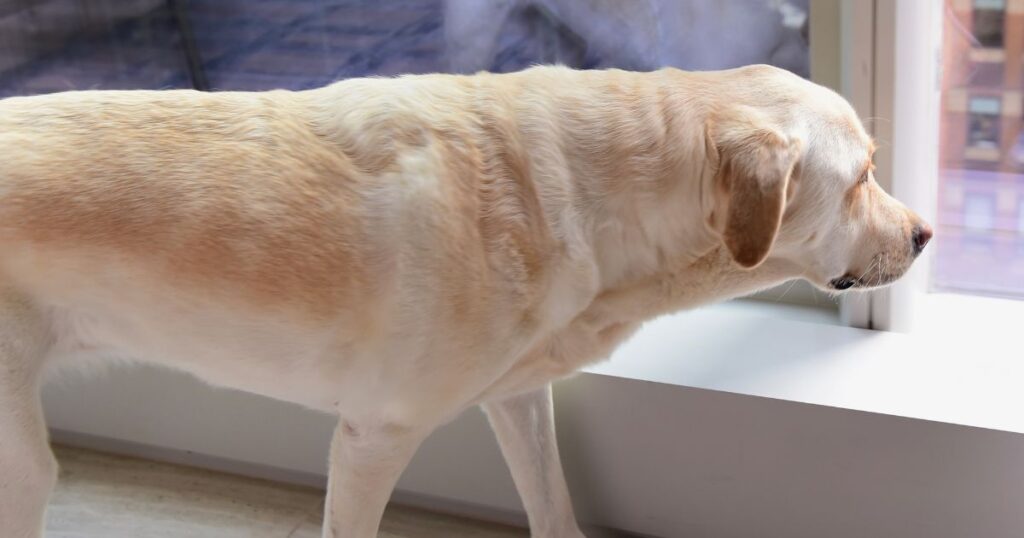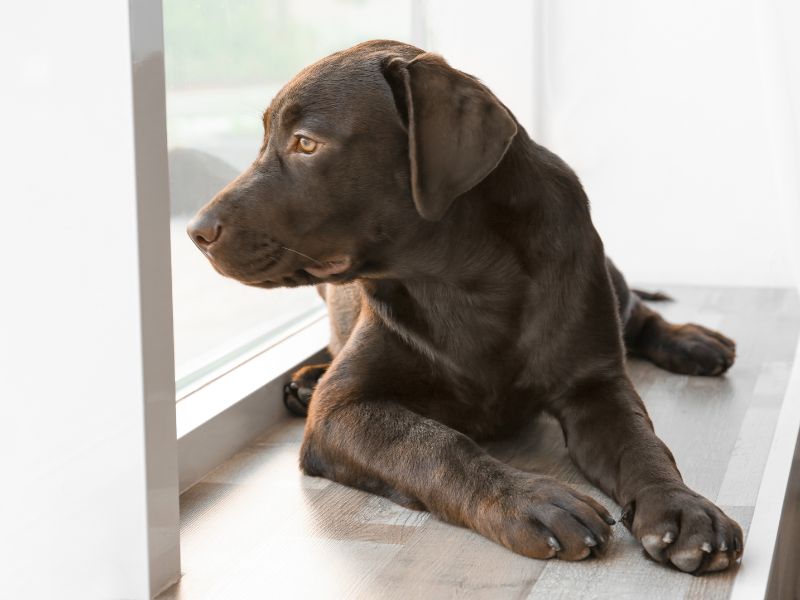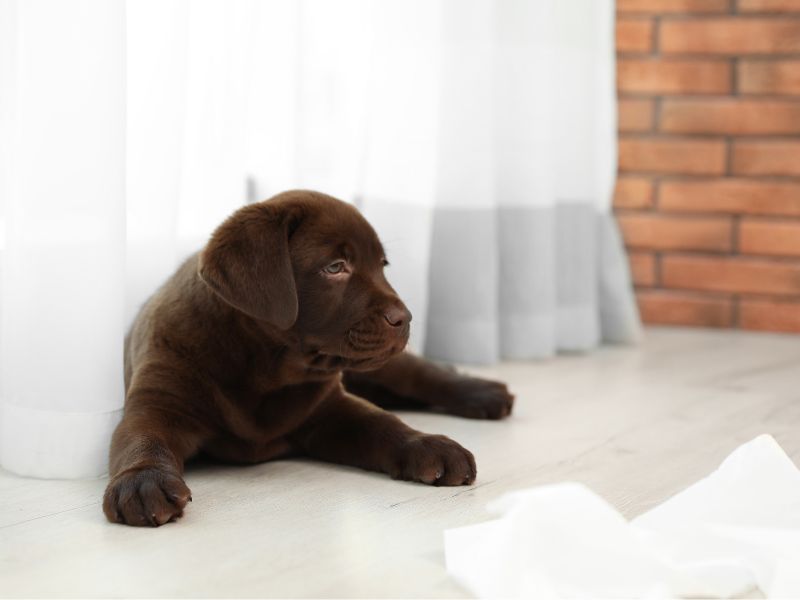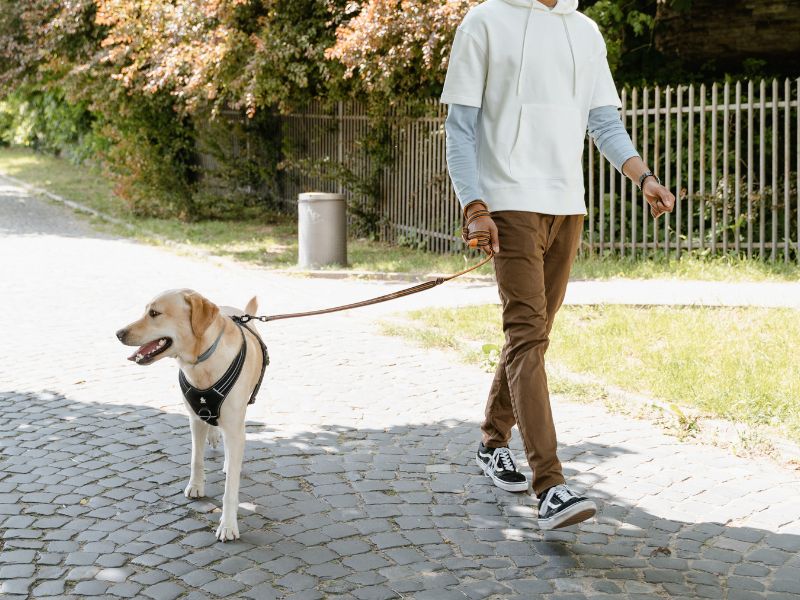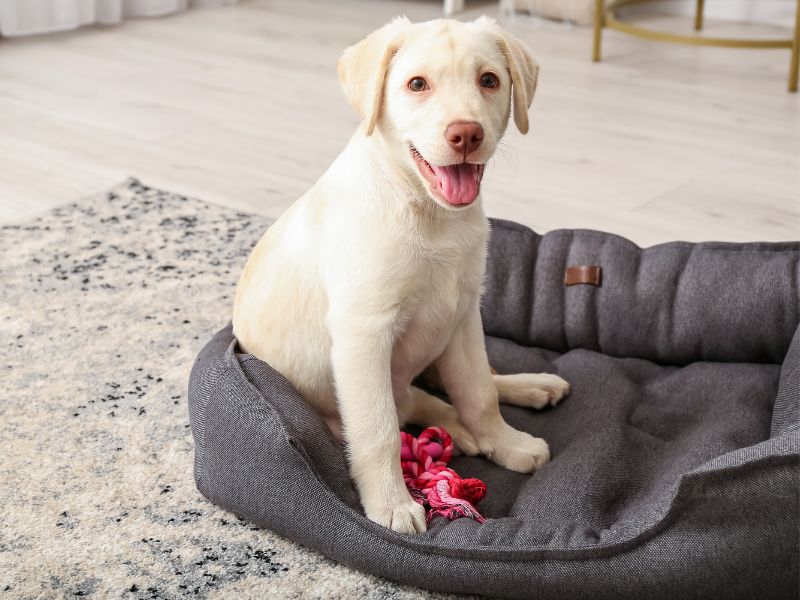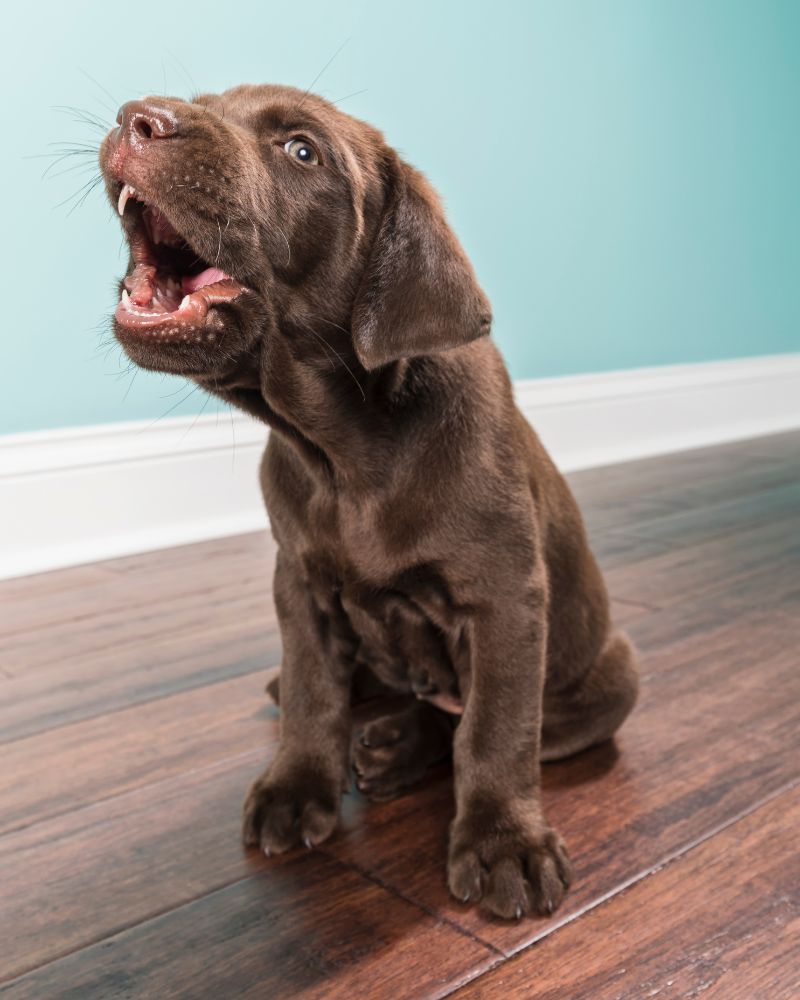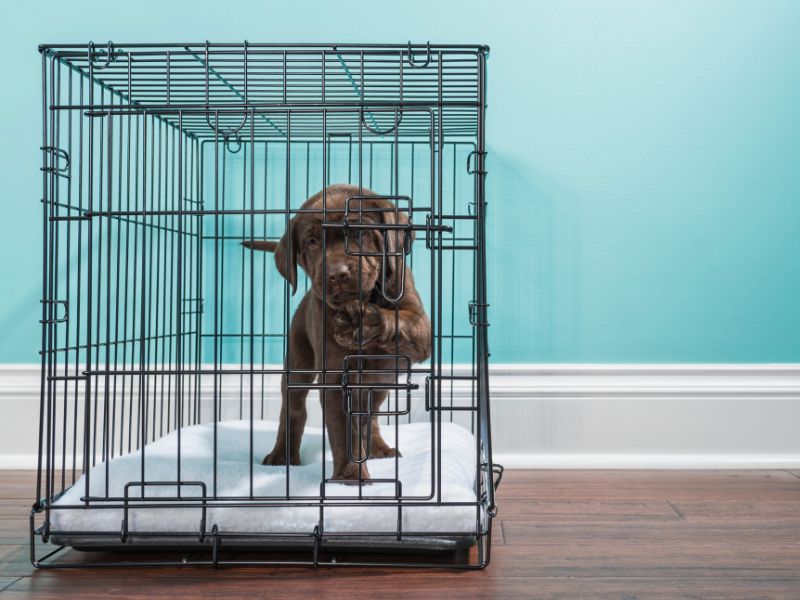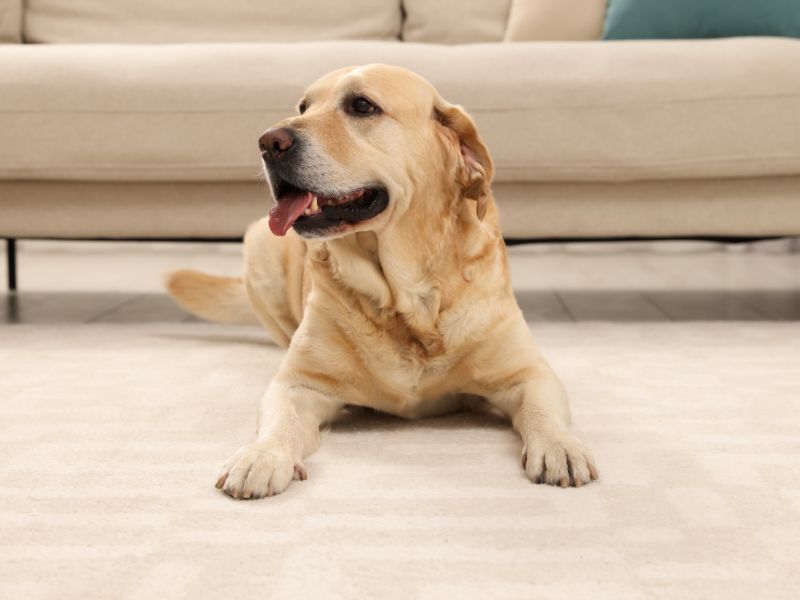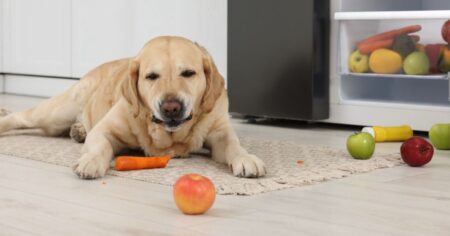Combining a Labrador puppy with full-time work can be a challenge, but it is possible to make it work with the right strategies and preparation. Many pet owners face the dilemma of wanting to bring home a new furry friend, but being worried about how they will manage their work schedule with the needs of a young puppy. Fortunately, there are steps that can be taken to ensure that both the puppy and the owner are happy and healthy.
One of the most important things to consider when raising a puppy while working full-time is creating a safe and comfortable environment for the puppy. This can include puppy-proofing the home, providing a comfortable bed, and ensuring that the puppy has access to food, water, and toys. It is also important to establish a routine that meets the puppy’s needs, including regular feeding, exercise, and bathroom breaks. With the right preparation and care, it is possible to successfully combine a Labrador puppy with full-time work.
Why Keep A Dog When You Work Full Time
Many people are hesitant to get a dog when they work full time, but there are actually many benefits to dog ownership that make it worthwhile. In this section, we will explore some of the reasons why someone might choose to keep a dog despite having a full-time job.
Benefits To Dog Ownership
Owning a dog can have many benefits, both for the owner and the dog. Dogs are known for their loyalty and companionship, and can provide emotional support to their owners. They can also help to reduce stress and anxiety, and can be a great source of exercise and motivation to stay active.
In addition, dogs can be trained to perform a wide variety of tasks, from assisting people with disabilities to providing security and protection. They can also be trained to perform tricks and other fun activities, which can be a great source of entertainment and bonding for both the owner and the dog.
Dogs Are Family
For many people, their dog is not just a pet, but a member of their family. Dogs have a unique ability to form strong bonds with their owners, and can provide a sense of love and companionship that is difficult to find elsewhere. They can also be a great source of comfort and support during difficult times, and can help to create a sense of community and belonging.
Overall, while owning a dog when you work full time can be challenging, the benefits of dog ownership can make it well worth the effort. With proper training and care, a dog can be a loyal and loving companion for many years to come.
Leaving A Dog Home Alone While At Work
Leaving a Labrador puppy home alone while at work can be a challenging experience for both the puppy and the owner. Puppies are social creatures and require lots of attention and care. However, with the right preparation and training, it is possible to leave a puppy alone for a few hours.
One important aspect to consider is the puppy’s designated space. Designate a space in your home where your puppy can feel safe with their bed, a few toys, food, and water. Using a pet fence can keep them in their designated space and prevent them from wandering around the house and getting into trouble.
Another important aspect is feeding and watering the puppy. A spill-proof bowl is a great idea, one that is heavy enough so that they can’t easily knock, tip, or flip it over. It’s also important to ensure that the puppy is properly fed before leaving for work, and that they have access to water throughout the day.
Training the puppy to be comfortable alone is also crucial. Start by leaving the puppy alone for short periods of time and gradually increase the duration. Provide them with toys and treats to keep them occupied and distracted. Using a camera like the Furbo Dog Camera can also help keep an eye on the puppy while away.
Overall, leaving a Labrador puppy home alone while at work requires careful planning and preparation. By providing a designated space, proper feeding and watering, and training, the puppy can learn to be comfortable and happy alone.
Can I Have A Puppy When I Work? Would That Be Wrong?
Many people wonder if they can have a puppy while working full time. The answer is yes, but it requires careful planning and consideration. It is important to ensure that the puppy will receive adequate attention, exercise, and training. Leaving a puppy alone for long periods of time can lead to behavioral issues such as separation anxiety, destructive behavior, and excessive barking.
One option for those who work full time is to hire a dog walker or pet sitter to come and take the puppy for a walk and provide some attention during the day. Another option is to enroll the puppy in a doggy daycare program where they can socialize and play with other dogs while being supervised.
It is also important to establish a routine for the puppy that includes regular feeding times, exercise, and training sessions. This routine can help the puppy feel more secure and reduce the likelihood of behavioral issues.
Overall, it is possible to have a puppy while working full time, but it requires planning, commitment, and a willingness to provide the puppy with the attention and care they need.
How Long Can You Leave A Puppy Alone?
Leaving a puppy alone is a common concern for pet owners who work full-time. While it’s important to provide your puppy with attention and care, it’s also important to ensure that they are comfortable and safe when left alone.
Can I Leave My 8 Week Old Puppy Home Alone?
No, you should not leave an 8-week-old puppy alone for any length of time. Puppies at this age require constant attention and care. They need to be fed every few hours and require frequent potty breaks. Leaving them alone can cause anxiety, stress, and even health problems.
How Often Does A Puppy Need To Go Out?
Puppies need to go out frequently, especially during the first few months of their life. A general rule of thumb is to take them out every hour for each month of age. For example, a 3-month-old puppy should be taken out every three hours. As they get older, they can hold their bladder for longer periods of time.
How Long Can A Puppy Be Left Alone From 10-12 Weeks Of Age?
At 10-12 weeks of age, puppies can be left alone for up to two hours. However, it’s important to gradually increase the time they spend alone. Leaving them alone for too long can cause separation anxiety and other behavioral problems.
How Long Can Puppies Be Left Alone From 3-6 Months Of Age?
From 3-6 months of age, puppies can be left alone for up to four hours. However, it’s important to provide them with plenty of toys and activities to keep them occupied. You can also use food-filled toys to keep them entertained and mentally stimulated.
Overall, it’s important to remember that puppies require a lot of attention and care. If you work full-time, it’s important to make arrangements to ensure that your puppy is safe and comfortable when left alone. This may include hiring a dog walker or pet sitter, or enrolling them in a doggy daycare program.
Setting Up A Puppy Zone
Bringing a new puppy home is an exciting experience, but it can also be a bit overwhelming, especially if you work full-time. One of the most important things you can do to make your puppy feel safe and comfortable is to set up a designated puppy zone.
A Puppy Proof Room
One option is to designate a room in your home as your puppy’s space. This room should be puppy-proofed to ensure your furry friend doesn’t get into anything dangerous. Remove any hazardous items, such as cleaning supplies, electrical cords, and small objects that could be swallowed.
Extreme Chewers
If your puppy is an extreme chewer, it’s important to make sure they have plenty of chew toys and bones to keep them entertained. You can also try spraying bitter apple spray on items you don’t want your puppy to chew on.
Puppy Pens And Barriers
Another option is to use a puppy pen or barrier to keep your puppy contained in a certain area. This is especially useful if you have a larger home or if you want to keep your puppy away from certain areas of the house. Puppy pens come in a variety of sizes and materials, so you can choose one that best fits your needs.
Overall, setting up a puppy zone is an important step in raising a happy and healthy puppy, especially if you work full-time. With a little planning and preparation, you can create a safe and comfortable space for your furry friend to thrive in.
How To Potty Train A Puppy When You Work
Potty training a puppy can be a challenging task, especially when you work full time. However, with patience and consistency, it is possible to train your puppy to go potty in the right place. Here are some tips to help you potty train your puppy when you work.
Establish A Routine
Establishing a routine is crucial when potty training a puppy. Take your puppy outside to go potty first thing in the morning, after meals, and before bedtime. When you are at work, try to stick to a similar routine. If possible, hire a dog walker or ask a friend or family member to take your puppy out during the day.
Use Positive Reinforcement
Positive reinforcement is an effective way to potty train a puppy. When your puppy goes potty in the right place, praise them and give them a treat. This will encourage them to repeat the behavior. Avoid punishing your puppy for accidents, as this can cause them to become fearful and anxious.
Crate Training
Crate training can be a useful tool for potty training a puppy. Dogs do not like to go potty where they sleep, so keeping your puppy in a crate when you are not home can help prevent accidents. Make sure the crate is the right size for your puppy and provide them with toys and treats to keep them occupied.
Puppy Pads
Puppy pads can be a helpful tool when potty training a puppy. Place the pads in a designated area and encourage your puppy to use them. Gradually move the pads closer to the door and eventually outside. This will help your puppy learn to associate going potty with being outside.
Remember, potty training a puppy takes time and patience. Be consistent, use positive reinforcement, and establish a routine to help your puppy learn to go potty in the right place.
Home Alone Puppy – What Can Go Wrong?
Leaving a puppy home alone for extended periods can lead to various problems. Puppies are social animals and crave human interaction. Without proper attention, they can become bored, anxious, and destructive. Here are some of the issues that can arise when leaving a puppy home alone for too long:
- Separation anxiety: Puppies that are left alone for extended periods can develop separation anxiety. They may become nervous, agitated, and destructive when left alone, leading to damage to furniture, walls, and floors.
- Boredom: Puppies that are left alone for long periods can become bored and restless. They may start to chew on furniture, shoes, and other objects to alleviate their boredom.
- Housebreaking issues: Puppies that are left alone for too long may have accidents in the house, making housebreaking more challenging.
- Lack of socialization: Puppies that are left alone for extended periods may not receive the necessary socialization, leading to behavioral issues such as aggression and fear.
To avoid these problems, it is essential to provide your puppy with the necessary attention, exercise, and mental stimulation. This can be achieved by hiring a dog walker, enrolling your puppy in doggy daycare, or asking a friend or family member to check in on your puppy during the day. Additionally, providing your puppy with interactive toys, such as food-filled Kongs, can help keep them occupied and mentally stimulated while you are away.
Get Pippa’s Training Tips!
If you’re thinking of combining a Labrador puppy with full-time work, it’s important to train your puppy to be well-behaved and independent. Pippa Mattinson, a best-selling author and Labrador specialist, provides detailed and in-depth training guides on a range of Labrador topics on The Labrador Site.
One of the most important things to keep in mind when training a puppy is consistency. It’s important to establish a routine and stick to it. This will help your puppy feel secure and know what to expect. Pippa recommends crate training as a way to help your puppy learn to be clean in the home and provide a place of safety when they need to rest or when you cannot supervise them.
Another important aspect of training is socialization. It’s important to expose your puppy to different people, animals, and environments to help them become well-adjusted and confident. Pippa recommends starting socialization early and gradually exposing your puppy to new experiences.
Finally, it’s important to be patient and positive when training your puppy. Puppies are still learning and may make mistakes, but with consistency and positive reinforcement, they can learn to be well-behaved and independent. Pippa’s training tips can help you successfully combine a Labrador puppy with full-time work.
Labrador Puppy Bed Wetting Or Peeing In The Crate
One common issue that new puppy owners face is bed wetting or peeing in the crate. It can be frustrating and messy, but it’s important to remember that it’s a normal part of the house training process.
To prevent bed wetting, it’s important to make sure your puppy has regular potty breaks. Take your puppy outside every few hours, after meals, and after naps. Praise and reward your puppy when they go potty outside to reinforce good behavior.
If your puppy does have an accident in the crate, clean it up immediately with an enzymatic cleaner to remove any lingering odor. Avoid using ammonia-based cleaners, as they can actually attract your puppy back to the same spot.
It’s also important to make sure your puppy’s crate is the appropriate size. A crate that is too big can lead to bed wetting, as your puppy may use one end of the crate as a bathroom and the other end as a sleeping area.
By following these tips and being patient, you can help your Labrador puppy learn to control their bladder and avoid bed wetting or peeing in the crate.
Does It Matter If A Puppy Wets His Bed?
Puppy parents often face the challenge of cleaning up accidents, and bedwetting is no exception. While it may seem like a minor inconvenience, it’s important to understand that bedwetting can be a symptom of a bigger health concern. Therefore, it is critical to address this issue as soon as possible.
One of the primary reasons puppies wet their beds is because they are not yet fully potty trained. It’s important to be patient with your puppy during this process and provide them with ample opportunities to go outside. Additionally, crate training can be helpful in preventing accidents while you are away at work.
However, if your puppy continues to wet their bed even after being potty trained, it may be a sign of an underlying health issue. For example, urinary tract infections, bladder stones, and kidney disease can all cause a puppy to wet their bed. Therefore, it’s important to take your puppy to the vet to rule out any potential health problems.
In conclusion, while bedwetting may seem like a minor issue, it is important to address it promptly. By providing your puppy with ample opportunities to go outside and crate training them, you can prevent accidents while you are away at work. If bedwetting persists, it may be a sign of an underlying health issue, and you should take your puppy to the vet for a check-up.
How Long Can A Dog Stay In A Crate?
Crate training is a popular method for housebreaking and training puppies. However, it’s important to ensure that the puppy is not crated for too long. According to The Labrador Forum, a puppy should not be crated for more than four hours in one spell during the day. Ideally, a puppy should be crated for a couple of hours when they would be sleeping anyway.
For adult dogs, the majority can stay in their crate for around half a day, according to Breed Advisor. However, it’s important to ensure that the dog is getting enough exercise throughout the day. If a dog is crated while the owner is at work, they should highly consider hiring a dog walker or pet sitter to take the dog out for a walk and provide some human interaction.
It’s important to note that crating a dog for too long can lead to negative consequences, such as anxiety, depression, and destructive behavior. Therefore, it’s crucial to provide enough exercise and mental stimulation for the dog, even when crated. Additionally, it’s important to ensure that the crate is the appropriate size for the dog, with enough room for them to stand up, turn around, and lie down comfortably.
Overall, while crating can be a useful tool for training and housebreaking, it’s important to ensure that the dog is not crated for too long and is provided with enough exercise and mental stimulation throughout the day.
Where To Leave A Puppy While At Work
Leaving a puppy alone at home for extended periods of time can be a difficult decision for any pet owner. However, with the right preparation and planning, it is possible to successfully combine a Labrador puppy with full-time work.
One option is to hire a professional dog walker or pet sitter who can visit the puppy during the day to provide companionship, exercise, and bathroom breaks. Another option is to enroll the puppy in a daycare program where they can socialize with other dogs and receive supervision and attention throughout the day.
If hiring a professional or enrolling the puppy in daycare is not feasible, pet owners can create a safe and comfortable environment for their puppy at home. This can be achieved by providing a designated area for the puppy, such as a crate or playpen, with plenty of toys and water. It is important to gradually introduce the puppy to the designated area and ensure that they feel comfortable and secure before leaving them alone for extended periods of time.
Pet owners can also consider installing a camera or monitoring system to keep an eye on their puppy while at work. This can provide peace of mind and allow them to check in on their puppy throughout the day.
Overall, there are several options available for pet owners who need to leave their Labrador puppy alone while at work. It is important to consider the puppy’s needs and personality when making the decision and to ensure that they are safe, comfortable, and happy while at home alone.
Howling And Barking
Labrador puppies can be prone to barking and howling, especially when they are left alone for long periods of time. This can be a problem for owners who work full-time jobs and cannot be with their puppies all day. However, there are ways to train your puppy to reduce their barking and howling.
One effective method is to gradually get your puppy used to being alone. Start by leaving them alone for short periods of time, and gradually increase the length of time they are left alone. This will help them feel more comfortable and less anxious when you are not around.
Another method is to crate train your puppy. Puppies need to be crate trained gradually for them to get used to the new environment and to see it as their den. They certainly shouldn’t be left in there for more than 4 hours at a time even when they are trained. The best way to start crate training is to do it while you’re at home and not while you’re at work.
It’s also important to identify the reason why your puppy is barking or howling. Sometimes, they may just be bored or need more exercise. Ensuring that your puppy gets enough exercise and mental stimulation can help reduce their barking and howling. Additionally, providing them with toys and treats can also help keep them occupied while you are away.
Overall, with patience and consistency, it is possible to train your Labrador puppy to reduce their barking and howling when left alone.
Monitoring
Monitoring a puppy when you work full-time is crucial to ensure their safety and well-being. It is recommended to use a puppy camera to keep an eye on your furry friend while you are away. With a puppy camera, you can check on your puppy’s behavior and make sure they are not getting into any trouble or showing signs of distress.
In addition to a puppy camera, it is important to monitor your puppy’s food and water intake. Make sure to leave enough food and water for your puppy to last the day. You can use a timed feeder to ensure your puppy is getting their meals at regular intervals.
It is also essential to monitor your puppy’s potty breaks. Puppies need to go outside frequently to avoid accidents in the house. If you cannot come home during the day, consider hiring a dog walker or asking a trusted neighbor to take your puppy out for a quick walk.
By monitoring your puppy’s behavior, food and water intake, and potty breaks, you can ensure that your furry friend is healthy, happy, and safe while you are at work.
The First Few Weeks
Bringing home a new Labrador puppy is an exciting time, but it’s important to remember that the first few weeks can be overwhelming for both the puppy and the owner. During this time, it’s crucial to establish a routine that works for both the puppy and the owner, especially if the owner works full time.
One of the first things to consider is where the puppy will sleep. It’s important to provide a comfortable and secure sleeping area for the puppy, whether it’s a crate or a designated puppy bed. The puppy should be able to sleep in a quiet area, away from distractions and noise.
Another important aspect of the first few weeks is establishing a feeding schedule. Puppies require frequent meals, so it’s important to feed them at regular intervals throughout the day. This can be challenging for owners who work full time, but there are ways to make it work. For example, the owner can feed the puppy before leaving for work, and then again when they return home.
It’s also important to establish a potty training routine during the first few weeks. Puppies need to go outside frequently, especially after meals and naps. The owner should take the puppy outside on a regular schedule, and praise them when they go potty outside. Consistency is key when it comes to potty training, so it’s important to establish a routine that works for both the puppy and the owner.
Overall, the first few weeks with a new Labrador puppy can be challenging, but with patience, consistency, and a bit of planning, it’s possible to successfully combine a puppy with full time work.
Crate Training A Puppy When You Work
Crate training is an essential part of raising a Labrador puppy when you work full time. It helps to keep your puppy safe and secure while you are away and prevents them from getting into trouble. When crate training a puppy, it is important to choose the right size crate. The crate should be big enough for your puppy to stand up, turn around, and lie down comfortably, but not so big that they have enough space to use one end as a bathroom and the other end as a sleeping area.
When crate training a puppy, it is essential to introduce them to the crate gradually. Start by placing treats inside the crate and letting your puppy explore it at their own pace. Once your puppy is comfortable inside the crate, start closing the door for short periods while you are at home. Gradually increase the amount of time your puppy spends inside the crate until they are comfortable being inside for several hours at a time.
It is important to note that crate training should not be used as a form of punishment. Your puppy should view their crate as their own personal space, not a place where they are sent when they misbehave. Additionally, it is important to provide your puppy with plenty of exercise and attention when you are at home, so they do not become bored or anxious when they are inside the crate.
Overall, crate training is an effective way to help your Labrador puppy feel safe and secure while you are away at work. By taking the time to introduce your puppy to the crate gradually and providing them with plenty of exercise and attention when you are at home, you can help ensure that they are happy and healthy as they grow and develop.
Keeping Your Puppy Company When At Work
It’s important to make sure your puppy doesn’t get lonely or bored while you’re at work. Here are some tips to keep your puppy company:
- Dog Walker: Hire a dog walker to take your puppy for a walk during the day. This will give your puppy some exercise and socialization.
- Doggy Daycare: Consider sending your puppy to a doggy daycare. This will provide your puppy with playtime, socialization, and supervision.
- Puzzle Toys: Provide your puppy with puzzle toys to keep them entertained and mentally stimulated. These toys can keep your puppy busy for hours.
- Dog Camera: Install a dog camera in your home so you can check on your puppy throughout the day. Some dog cameras even allow you to talk to your puppy and dispense treats.
- Crate Training: If your puppy is comfortable in a crate, consider crate training. This will provide your puppy with a safe and comfortable space to rest while you’re away.
Remember, puppies need a lot of attention and care. Make sure to spend quality time with your puppy when you’re home, and provide them with plenty of love and affection.
Entertaining Your Puppy When You Work
It’s important to keep your puppy entertained and mentally stimulated while you’re at work. This will help prevent destructive behaviors and keep your puppy happy. Here are some tips to help you entertain your puppy when you’re not home:
- Provide toys: Leave a variety of toys for your puppy to play with. Puzzle toys that dispense treats can keep your puppy occupied for hours.
- Leave the TV or radio on: The sound of voices can be comforting to your puppy and help them feel less alone.
- Use a dog walker or doggy daycare: If possible, hire a dog walker to take your puppy for a walk during the day. Alternatively, consider enrolling your puppy in a doggy daycare program.
- Train your puppy: Use positive reinforcement training techniques to teach your puppy new tricks and behaviors. This will help keep their mind active and engaged.
- Rotate toys: Switch out your puppy’s toys every few days to keep things interesting. This will prevent your puppy from getting bored with their toys.
Remember, it’s important to spend quality time with your puppy when you’re home. Play with them, take them for walks, and give them plenty of attention. This will help strengthen your bond with your puppy and keep them happy and healthy.
Looking Ahead To Your Older Dog
It’s important to think about the long-term when bringing a puppy into your home, especially if you work full-time. While it may seem overwhelming at first, with proper planning and care, your puppy can grow into a happy and healthy adult dog.
As your puppy grows, their needs will change. They will require less supervision and more exercise and mental stimulation. It’s important to continue to provide them with plenty of opportunities to socialize and learn new things.
One way to ensure your older dog stays healthy and happy is to provide them with regular veterinary care. This includes annual check-ups, vaccinations, and preventative care for common health issues such as fleas, ticks, and heartworm.
As your dog ages, they may also require changes to their diet and exercise routine. Your veterinarian can help you determine the best course of action based on your dog’s individual needs.
Ultimately, with proper care and attention, your puppy can grow into a beloved companion for many years to come.
Your Dog Care Back Up
It’s important to have a plan in place for your Labrador puppy’s care when you can’t be there. Here are some options to consider:
- Doggy Daycare: A great option for socializing your puppy and providing exercise during the day. Make sure to choose a reputable facility that provides adequate supervision and playtime.
- Pet Sitter: Hire a pet sitter to come to your home and care for your puppy. This can be a good option if your puppy is anxious around other dogs or if you prefer to keep them in a familiar environment.
- Neighbor or Friend: If you have a trustworthy neighbor or friend who is willing to help out, this can be a great option. Make sure to provide clear instructions and any necessary supplies.
- Work from Home: If your job allows for it, consider working from home a few days a week to spend more time with your puppy.
Remember to always have a backup plan in case of emergencies or unexpected events. It’s important to make sure your puppy is well-cared for and happy, even when you can’t be there.

